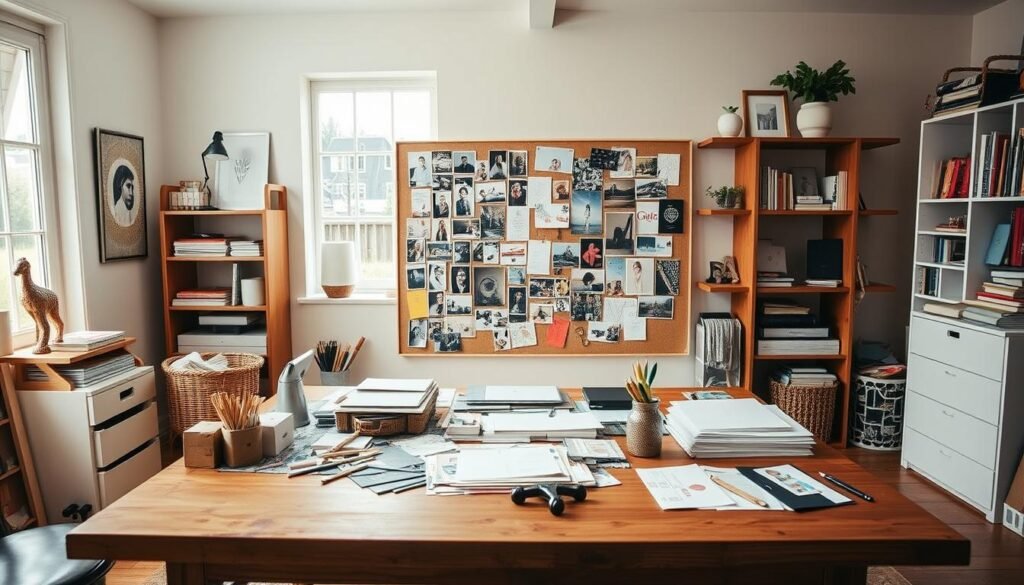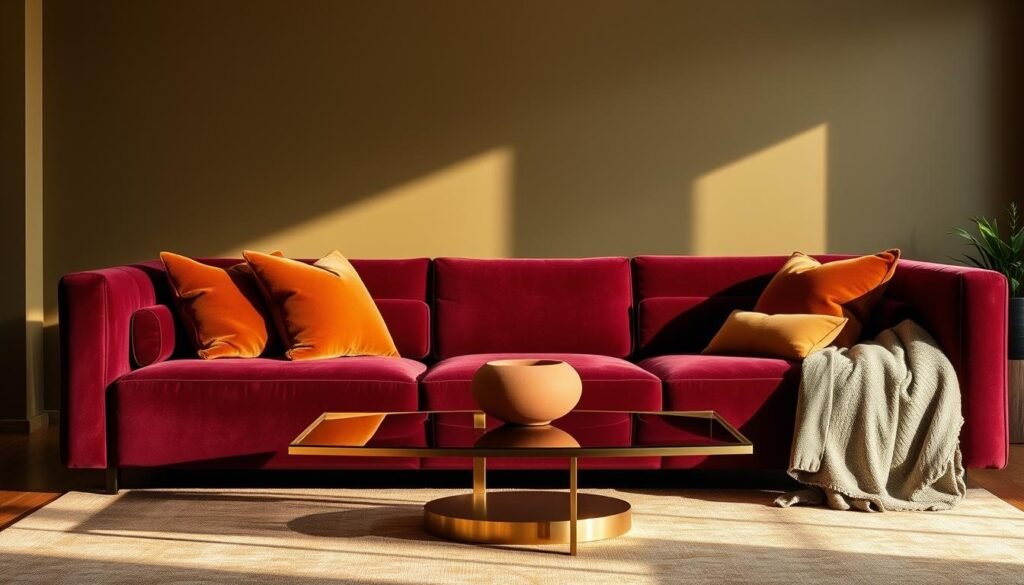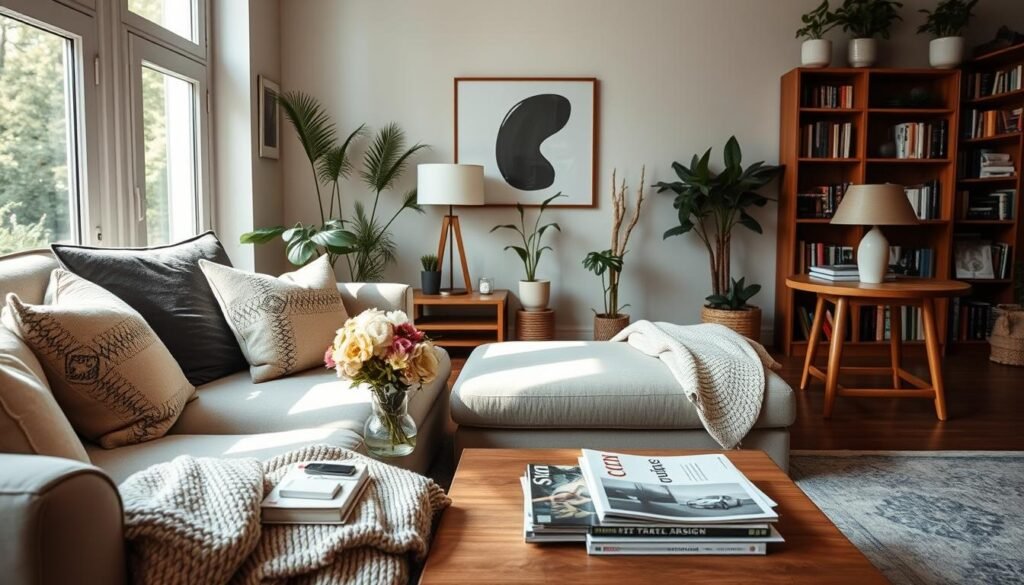Creating a polished living environment doesn’t require a hefty budget or formal training. Many believe expert-level design hinges on expensive consultants, but the truth lies in mastering a few core principles. Interior specialists consistently notice thoughtful details—like antique furniture with history or bold wall treatments—that elevate spaces from ordinary to extraordinary.
What makes a room stand out? Designers often point to unexpected choices, such as olive-green trim or gallery walls filled with meaningful art. These elements showcase confidence and personality while maintaining functionality. The secret isn’t imitation but blending timeless techniques with items that tell your story.
This guide breaks down the methods professionals use to craft cohesive, inviting spaces. You’ll learn how to balance color theory with practical layouts and select pieces that spark joy. Whether refreshing a single room or overhauling your entire interior, these strategies ensure every choice feels intentional.
Key Takeaways
- Expert-level design focuses on intentional details rather than expensive purchases
- Bold color choices and personalized decor impress design professionals
- Successful spaces combine functionality with emotional resonance
- Quality furnishings with history add depth to modern interiors
- Strategic planning creates harmony between different design elements
The Importance of Professional Home Styling
Great spaces don’t happen by accident—they’re built through intentional choices that balance beauty with purpose. When done right, these decisions create rooms that feel like extensions of your personality while impressing even seasoned design experts.
Understanding the Impact of Thoughtful Design
What separates ordinary houses from extraordinary homes? It’s the emotional resonance created through details that serve both form and function. Design professionals notice when spaces showcase:
- Confidence in bold choices (like olive-green trim)
- Functional layouts that enhance daily routines
- Personal artifacts displayed as curated collections
One designer notes: “The best interiors tell stories through their furnishings—a worn leather chair from a Paris flea market says more than a showroom replica ever could.”
Green Flags That Impress Interior Designers
Experts appreciate when homeowners prioritize quality over quantity. Sculptural sinks in bathrooms or bespoke curtains demonstrate investment in craftsmanship. These elements work best when paired with:
- Antique pieces with visible history
- Gallery walls mixing family photos with modern art
- Wallpaper patterns that command attention
This approach creates depth that flat, trend-chasing designs often lack. The result? Spaces that feel lived-in yet refined—a balance that truly defines professional-level styling.
Preparing a Clean Canvas for Design Success
Before adding decor, experts recommend stripping back to essentials. A clutter-free environment lets architectural details breathe and creates room for intentional styling. Design professionals consistently emphasize that even expensive furnishings lose impact when competing with disorganized spaces.
Decluttering Your Space for a Fresh Start
Effective organization goes beyond tidying up. It’s about creating systems that highlight your favorite items while hiding daily necessities. Start by sorting belongings into three categories:
- Keep: Objects with functional or emotional value
- Store: Seasonal or rarely used pieces
- Donate: Items that no longer serve their purpose
This process reveals hidden potential in your room. Natural light flows better through clean windows, and empty walls become opportunities for gallery displays. One designer notes: “Clients often discover beautiful flooring or moldings they’d forgotten existed.”
| Decluttering Approach | Key Benefit | Time Required |
|---|---|---|
| Minimalist Edit | Maximizes visual space | 2-4 hours |
| Curated Selection | Highlights meaningful items | 1 full day |
| Full Overhaul | Resets entire layout | Weekend project |
After decluttering, observe how sunlight moves through the space at different times. This awareness helps position furniture to enhance natural illumination. Remember – a clean canvas isn’t empty, but thoughtfully prepared to showcase design choices that matter.
Crafting Your Personal Mood Board
A mood board bridges imagination and execution in interior projects. This visual tool helps spot patterns in your taste before buying furniture or paint. Start by collecting 50+ inspiration images on Pinterest—rooms, color combinations, and standalone furniture pieces.

Gathering Inspiration and Ideas
Professional designers swear by this step: Pin freely without overthinking. Focus on shots with plain backgrounds to see shapes clearly. One decorator shares: “Clients often realize they prefer curved furniture legs after seeing 20 examples together.”
Ask three guiding questions as you collect:
- What activities will this space support daily?
- Should the atmosphere feel energizing or calming?
- How can colors enhance the room’s purpose?
Refining Your Unique Design Vision
After pinning, look for repeating elements. You might notice:
- Three similar green tones across different rooms
- Frequent use of woven textures
- Mid-century modern lamps in contemporary settings
Edit your board to 15-20 strongest images. Identify connections between them—maybe all feature matte finishes or organic shapes. This process reveals preferences you didn’t consciously recognize, helping craft spaces that feel authentically yours yet professionally polished.
Establishing a Sophisticated Color Palette
In the world of interior design, color wields transformative power that goes beyond mere decoration. The right combination of hues sets emotional tones while anchoring visual harmony. Professionals achieve this balance by building layered schemes that evolve with daylight and artificial illumination.

Mixing Neutrals with Purpose
Start with foundation shades that create calm sophistication. Deep earth tones and warm taupes offer versatility, letting furniture and art take center stage. Consider these classic pairings:
| Neutral Base | Complementary Accent | Lighting Effect |
|---|---|---|
| Warm White | Blackened Brass | Enhances golden-hour glow |
| Slate Gray | Unlacquered Brass | Adds depth in low light |
| Oatmeal Beige | White Oak | Softens midday brightness |
Introduce subtle contrast by blending warm and cool neutrals. A gray sofa against caramel walls creates quiet drama. Metals like satin nickel bridge temperature differences while developing character over time.
Bold accents thrive when used sparingly. Try emerald-green bookcases flanking a neutral wall or burnt-orange curtains framing white windows. These pops of color energize without overwhelming.
Wood grains act as natural texture enhancers. White oak floating shelves or walnut frames bring organic warmth to cool-toned rooms. Always test paint samples at dawn, noon, and under evening lamps—colors shift remarkably throughout the day.
Mixing Textures and Patterns for Added Depth
Texture transforms rooms from flat to fascinating. Designers achieve this magic by blending materials that engage both eyes and fingertips. A velvet sofa paired with linen pillows creates instant contrast, while brushed brass lamps add reflective surfaces that play with light.
Combining Fabrics, Metals, and Natural Elements
Start with foundational pieces that offer tactile variety. Upholstered chairs in performance fabrics (50,000+ double rubs) withstand daily use while maintaining softness. Layer in nubby wool throws or silk accent pillows for visual intrigue.
Natural materials ground modern spaces beautifully. Try pairing:
- Reclaimed wood side tables with chrome legs
- Jute rugs beneath glossy marble coffee tables
- Woven baskets holding smooth ceramic vases
Metallic finishes work best when mixed intentionally. Combine matte black iron sconces with polished nickel drawer pulls. This contrast prevents monotony while adding subtle sophistication. Glass tabletops or pendant lights introduce transparency, keeping heavy textures from overwhelming.
One designer shares: “Great rooms have texture hierarchies – dominant, secondary, and accent materials that create rhythm.” For example, make leather your primary texture, stone the secondary, and incorporate metallic accents through decor.
Remember – successful layering balances proportions. Rough surfaces need smooth counterparts, while matte finishes benefit from occasional gloss. Test combinations by touch and sight: if everything feels similar, add something unexpectedly tactile.
How to style your home like a professional with Quality Furniture
Furniture forms the backbone of any well-designed interior, blending daily function with lasting beauty. Design experts focus on pieces that work harder and longer, creating spaces that adapt to changing needs while maintaining elegance.
Investing in Timeless, Well-Made Pieces
Quality over quantity remains the golden rule for enduring interiors. Look for furniture with kiln-dried hardwood frames and dovetail joints—features that withstand decades of use. These construction details prevent warping and ensure stability, even in busy households.
| Material | Key Features | Average Lifespan |
|---|---|---|
| Solid Hardwood | Resists scratches, develops patina | 50+ years |
| Top-Grain Leather | Softens with age, hides wear | 25-30 years |
| Performance Fabric | Stain-resistant, easy cleaning | 15-20 years |
Custom furniture solves unique spatial challenges. A local craftsman can create window seats that double as storage or dining tables sized for large gatherings. As one designer notes: “Tailored pieces become family heirlooms—they’re literally built around your life story.”
Balancing Comfort and Aesthetics
Great furniture invites relaxation without sacrificing sophistication. Deep-seated sofas with down-filled cushions offer plush comfort, while clean-lined silhouettes keep the look polished. For active households, consider these resilient options:
- Crypton fabric sectionals that repel juice spills
- Slipcovered chairs with washable linen
- Reclaimed wood coffee tables hiding minor scratches
Leather remains a smart choice for families. It develops character marks that tell your story, while simple wipe-downs maintain freshness. Pair these practical selections with sculptural accent chairs or hand-carved consoles to elevate the entire space.
Lighting Techniques: Setting the Perfect Ambiance
Light transforms interiors more powerfully than any decor choice. The right illumination elevates both practical use and emotional impact, turning ordinary areas into dynamic environments. Professionals achieve this magic through strategic layering and fixture selection.
Layering Ambient, Task, and Accent Lighting
Ambient lighting acts as your foundation—think recessed ceiling lights or elegant chandeliers. These sources provide overall brightness while setting the mood. Task lighting then targets specific activities: under-cabinet strips for meal prep, adjustable desk lamps for reading.
Accent lights add drama. Picture wall sconces highlighting artwork or LED strips illuminating shelving displays. “Dimmer switches let these elements collaborate,” notes a New York designer. Adjustable controls allow seamless transitions from morning productivity to evening relaxation.
Choosing Fixtures That Enhance Your Interior
Fixtures should complement your space’s proportions and design theme. Oversized pendants anchor dining areas, while slim-profile flush mounts suit compact rooms. Mix metallic finishes for depth—brass table lamps paired with nickel track lighting create visual interest.
Minimalist spaces benefit most from sculptural pieces. A single bold chandelier can become the room’s focal point, proving that functional elements also serve as art. Always prioritize dimmable options to maximize versatility across daily routines.

